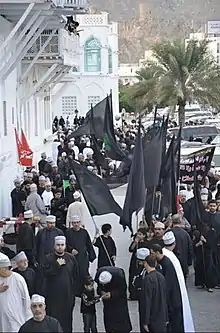
.jpg.webp)
Al-Lawatia (Arabic: اللواتية; Sindhi: لا واٽي, sing. Lawati) is a prominent merchant tribe mainly based in the province of Muscat, Oman who are the speakers of the Luwati language, which is a Sindhi based language. There are around 30,000 Luwatis (or 1% of Omanis) in Oman.[1]
Many Lawati families of successful merchants of the past are now involved in large multi-faceted corporations participating in the development of the region.
Origins
The Lawatia (or Lawatiyya) community in Muttrah in Muscat has its origins in the Sindh province of Pakistan.[2] They immigrated to Oman between 1780 and 1850. Luwatis converted to Twelver Shia Islam in the 19th century from Ismaili Shia Islam.[3]
Demographics and role in the Persian Gulf
The majority of Lawatis reside in Muscat, the capital of Oman, but some live on the coast of Al-Batina. Some Lawati families reside elsewhere in the Persian Gulf region such as the United Arab Emirates, Qatar, Bahrain and Kuwait.
Traditionally, Al-Lawatia have been known as prominent merchants on the coasts of Muttrah which lies 2 kilometers west of Muscat. They have worked in the incense (بخور), jewelry and clothes business as well as in general trade. The community occupies a gated quarter of Muttrah known as Sur al-Lawatia. In the predominantly Ibadi Sunni arena of Oman, they make up the majority of the local Shia population.[4] The quarter still boasts attractive houses with a unique Islamic architectural view and a large mosque known as Al-Rasul Al-Aadam Mosque or The Greatest Prophets Mosque in reference to Muhammad. The Sur has seen a major exodus in recent decades as Lawatis have moved to more modern neighborhoods as a result of increasing development, the availability of facilities and growing wealth and business of the community. Another great historic monument built by the tribe is Al-Zahra Mosque in the UAE, which was built nearly 300 years ago.[5]
History and notable families
The first historical mention of the Lawatis is said to have been by the Omani historian Ibn Ruzayq, who said that notables of the community greeted the first ruler of the currently ruling Al Said dynasty on his arrival to Muscat in the 1740.[6]
At least one Lawati family can be documented through British records as existing in Oman since the 1700s, those were the first group came to serve the British crown
One of the most notable political families from the Al-Lawati tribe is Al-Abdulateef family. Al Hajj Baqer, one of the pioneer merchants in Muttrah and well-respected public figure, lead the tribe as the Lawati sheikh. He enjoyed a strong relationship with the ruling Al Said house, particularly Sultan Said bin Taimur. It is widely known that he privately aided the Omani government's efforts in expelling the Saudi contingents from Al Buraimi in 1952.[7]
It is notable that the first woman ambassador from Oman was Khadijah bint Hassan al-Lawati, a Lawati woman appointed to the Netherlands in 1999.[8]
Religion
Verbal history indicates that at one point they were Muslim Shia in various branches. They now follow the Twelver Shia Islam. Consequently, the new adopted doctrine of Twelver/Jaafari grew within the Lawati tribe and the different branches were not accepted. Hence, some retracted while others detached from the community. However, most present-day Lawatis are known to be Twelver Shia Muslims. And with the process of mingling with the other groups, few Lawatis brought up through mixed marriages either following mixed Shia/Sunni or Shia/Ibadhi traditions. However, Laurence Louër, in his book Transnational Shia Politics: Religious and Political Networks in the Gulf, mentions a different theory of the religious origins of Al-Lawati. According to this theory, the Lawatis were Ismailis who migrated to Oman from Sindh in the 19th century, before converting to Twelver Shi'ism following a dispute with the leadership of the community.[9]
Language
The native mother language of Al-Lawaties is Lawati language which is called in their own tongue as (Khojki). This idiom is genetically and morphologically related to the Sindhi language; a branch of the Indo-European tree. As it also shares common similarities with other spoken languages of the other ethnic groups in Oman e.g. Jadgali , Maimani and Al Saigh. Elderlies were fluent in both the written and the spoken Khojki.[10]
Arabic as a first language of Oman and all Arabia, is also held tightly by Al-Lawaties in parallel with their mother tongue language Khojki. However, the trend now within this community is to abandon their own native language and more people of the young generation are found not to know how to write nor speak it, most Lawatis today are not as fluent in Kojki as their ancestors as they consider Arabic their mothertongue with Kojki and English relegated to secondary languages.
See also
References
- ↑ Valeri, M. "Identity Politics and Nation-Building under Sultan Qaboos". Sectarian Politics in the Persian Golf. 179.
- ↑ "Oman". The Encyclopaedia Britannica.
- ↑ Wippel, Steffen (2013-08-16). Regionalizing Oman: Political, Economic and Social Dynamics. Springer Science & Business Media. p. 272. ISBN 978-94-007-6821-5.
- ↑ "What's So Secret About Oman's 'Forbidden City', Sur Al Lawatia?". Culture Trip.
- ↑ Al-Lawati, Jawad bin Jaafar bin Ibrahim Al-Khabouri. The Omani Role in the Indian Peninsula: The Role of Bani Sama Ibn Loaey (Al-Lawatia). Muscat, Oman: Dar Al-Nubala, 2001.
- ↑ Ibn Ruzayq, Humaid. Al-Deya’a Al-Shay’e Bil Lama’an, Muscat (الضياء الشائع باللمعان – ابن رزيق)
- ↑ قدوة الفقهاء والعارفين السيد حسين العالم بن أسد الله الموسوي: سيرة حياته الربانية وشرح سياحاته العرفانية - تقي بن السيد حسين الموسوي
- ↑ "Ethnography - Al-Lawatia SIL in Eurasia". SIL International.
- ↑ Laurence Louër (2008) Transnational Shia Politics: Religious and Political Networks in the Gulf. Columbia University Press, pp. 147
- ↑ Al Jahdhami, S. "Minority Languages in Oman". Journal of the Association for Anglo-American Studies. 4: 105–112.